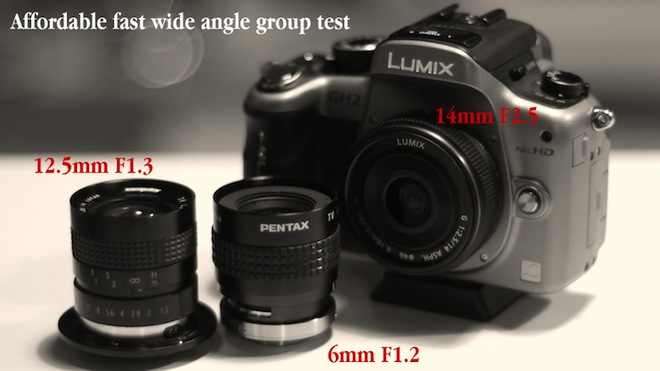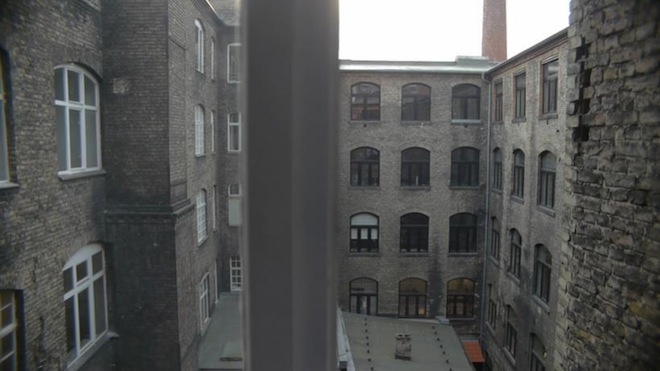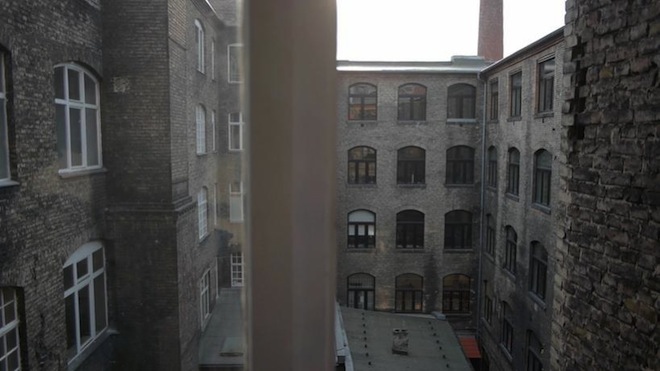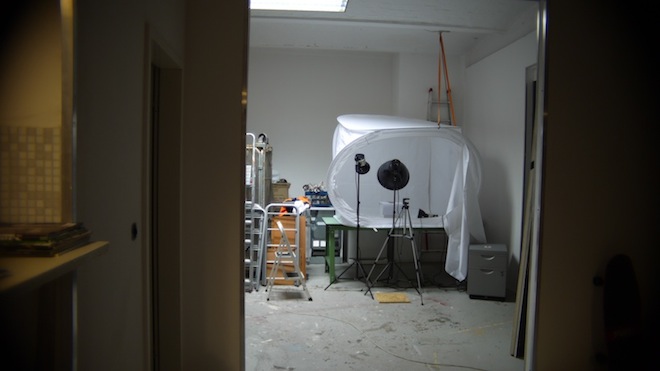
The Lumix 14mm F2.5 pancake is currently my favoured option on the GH2 but there are some more affordable alternatives for budget filmmakers.
- In the red corner is the Computar 12.5mm F1.3
- In the blue corner is the Pentax 6mm F1.2
Here I’ll compare them both to Panasonic’s tasty pancake.
I was recently talking to Dan Chung who has been somewhat let down with the lack of a good wide angle option for the GH2. He needs a fast aperture for low light AND very shallow depth of field at a wide angle. On Micro Four Thirds we can forget about it – you need to keep hold of a 5D Mark II to achieve that look. It is unique to the full frame sensor, where you have a Canon 24mm F1.4L which is truly wide and not a portrait lens like the Voigtlander 25mm F0.95 is on the GH2, albeit a beautiful one. Much of Dan’s shots are fast wides in the 24mm-35mm range, and he’s a shallow DOF junky!
The GH2 can do shallow depth of field but it’s much more limited with wide angles, because you have to go out to 14mm to get a wide angle on the crop sensor, and by that focal length most of the shallow depth of field you get with a fast 24mm or 35mm has disappeared. You do however maintain a good level of low light performance if the aperture is fast enough.
So this test is not really aimed at Dan, or those with higher budget gear, or pros – this is for the no budget filmmaker, to whom the Lumix pancake is a bit pricey.
And it’s not to say we can’t get a shallow depth of field at 12mm or 14mm full stop – since DOF also depends on the distance from the lens of the object in focus, the distance of the background to the object, and the aperture of the lens.
The faster apertures of these Computar and Pentax c-mount lenses would seem very attractive at first glance especially at such wide angles. But both lenses vignette. The 6mm so severely you have to use it in crop mode (ETC) but the 12.5mm is quite remarkable for a wide angle c-mount in this regard – it only vignettes by roughly 20% into the full frame. It almost covers – especially on the GF2 with it’s standard Micro Four Thirds sized sensor and not the oversized mutli-aspect GH2 CMOS.
The fast aperture is totally necessary on the Pentax since you can’t use high ISOs in ETC mode, it’s very noisy. I tend to stick to below ISO 800 in this mode, and sometimes you get noise on greys and shadows even at ISO 160 in this mode, depending on available light. In bright daylight it’s fine, but then why use a fast aperture? The noise in low light cancels out the Pentax’s main advantage, which is it’s F1.2 aperture. But for a $40 lens it is great value, and sharp if you stop down to F2. I just prefer to use the pancake at higher ISOs and sacrifice the faster aperture, because it results in a sharper, more detailed and less noisy image. This takes a bit to get your head around at first!
The Computar 12.5mm is a better option. Here, you do your crop in Final Cut Pro then upscale the image back to 1920×1080. It looks sharper than the Pentax and you can use the fast aperture of F1.3 AND high ISOs since you can use it in full sensor movie mode. No need for ETC mode here. It doesn’t quite match the colour, contrast or resolving power of the Lumix pancake though. But if you really do need to shoot at F1.3 and ISO 3200 in a wide angle shot, you can’t do any better. I have modified this lens so that it focusses to infinity without the need for machining or shaving the barrel down and it works a charm, so that it is another advantage over the Pentax – which you need to have machined or re-mounted to get infinity with.
Computar 12.5mm F1.3 @ F2

Lumix 14mm Pancake @ F2.5

The Lumix 14mm F2.5 is of course the most expensive option, but this has the least distortion, the best image, better colour and contrast, best resolution and of course covers the full frame. But as you can see below, after the crop is applied to the Computar 12.5mm c-mount in movie mode, you get roughly the same field of view with both.
On the GF2 since it has a standard sized Micro Four Thirds sensor unlike the GH2’s which is larger to support native 3:2 stills and native 16:9 movie recording, the 12.5mm vignettes even less because the GF2 crops the top and bottom in 16:9 mode, from a 4:3 image sensor. In 16:9 and 1:1 on the GF2 the Computar is capable of some great shots out of the box.
On the GF2, 16:9

On the GF2, 1:1

The Computar 12.5mm c-mount then comes highly recommended.


